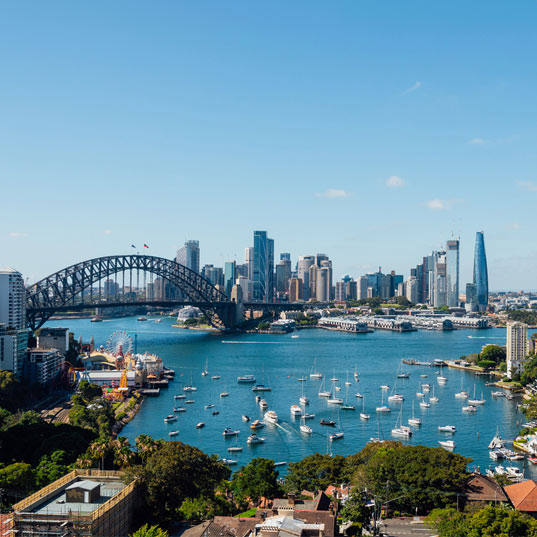Just 7 countries out of 134 analyzed meet World Health Organization air quality limits, according to a report by lQair, a Swiss company specializing in technologies to protect and control air quality.
So, which countries are leading the way toward cleaner air? Australia, Estonia, Finland, Grenada, Iceland, Mauritius and New Zealand. Below we examine the policies and practices that have allowed these nations to keep pollution levels down, so that they don’t pose a health risk to people and the planet.
What will I learn from this article?
- The impact of climate change on air quality
- Effective strategies in countries with the best air quality
The impact of climate change on air quality
The IQUAir 2023 World Air Quality Report analyzed the quality of air across the world, focusing on measuring fine particle (PM2.5) atmospheric pollution. These particles, with a diameter of 2.5 micrometers or smaller, are especially dangerous to human health due to their capacity to penetrate deep into lungs and the circulatory system, where they can cause a series of respiratory and cardiovascular problems.
IQAir found out that 92.5% of the 7,812 locations in 134 countries, regions and territories, where it examined average air quality last year, exceeded WHO PM2.5 standards. 6.7 million people die annually from the combined effects of environmental and domestic air pollution, according to the WHO.
The implications go far beyond the individual health level, however, affecting planetary health, too. Fossil fuel emissions, responsible for 65% of global CO2 emissions, are the main cause of most deaths related to PM2.5, underlining the connection between good and bad air quality and climate change.
The increase in temperatures is also playing a crucial role on PM2.5 concentrations via other pathways. Climate change accentuates drought and forest fires and can also alter weather patterns, causing changes in wind and rainfall. These changes directly affect the dispersion and elimination of PM2.5 in the atmosphere.
In many regions, intense pollution episodes coincide with extreme heatwaves aggravated by air stagnation, where weak winds allow contamination to accumulate. As climate change worsens, these events are forecast to become more common.
The world’s air is generally cleaner than for a large part of the previous century, says the report. But there are still some countries where pollution levels are dangerous. The most contaminated country, Pakistan, has PM2.5 levels 14 times greater than WHO standards, followed by India, Tajikistan and Burkina Faso.
Effective strategies in countries with the best air quality
IQAir highlights Finland, Iceland, Grenada, Mauritius, Estonia, New Zealand and Australia as the 7 countries whose atmosphere remains demonstrably clean thanks to advanced, sustainable, environmental policies. The report also publishes a list of recommendations for those countries wishing to reduce their polluting emissions.
Incorporation of WHO directives into national air quality standards
The first step in this roadmap is clearly to incorporate WHO air quality directives into national standards and strategies for air quality. These guidelines, based on abundant scientific proof, establishes the air quality levels needed to protect public health. Incorporating them into national norms and strategies is essential for any country that aspires to improve its air quality. The report recommends, for example, that those countries which suffer intense sand and dust storms clean streets in urban areas with high population densities and low rainfall. The aim is to prevent particles on the ground from rising and becoming suspended in the air.
Renewable energy for better air quality
Another fundamental aspect is the transition to renewable energy sources. This focus has been key for countries such as Iceland and Finland, which have undertaken significant investments in renewable energies and emission-free technologies.
Net emissions in Estonia - a country which up to 30 years ago depended entirely on fossil fuels but now produces a third of its electricity from renewable energies, with the aim of reaching 100% by 2030 - have fallen by 57% since 1990.
Meanwhile, Iceland achieved this goal some time ago. For years, the country of 380,000 inhabitants has generated 100% of its electricity, and 82.78% of total energy consumption, from renewable energies.
Toward sustainable and clean mobility
Finland, for its part, stands out for its adoption of urban mobility. Clean energies in public transport and promotion of walking and cycling are other strategies it has deployed. Helsinki is an exceptional example of this. The Finnish capital has implemented a series of innovations putting sustainable mobility first, including electric vehicles, an extensive network of cycle lanes, and expanding public transport networks such as new tram and light railway lines.
Preventing forest fires to improve air quality
Air quality in North America in 2023 was significantly influenced by extensive forest fires that ravished Canada from May to October, burning an area equivalent to around half of Germany.
During May, the average monthly PM2.5 level in Alberta was almost 9 times the same period in 2022. In 2023, 41% of Canadian cities recorded annual PM2.5 levels over double the WHO limit. As such, one of IQAir´s recommendations is to adopt strategies that help to mitigate forest fire risk. Australia is an example, where restoration of natural ecosystems is a key strategy for reducing forest fires, through projects such as replanting native species, habitat rehabilitation, and clearing combustible material.
Australia, Estonia, Finland, Grenada, Iceland, Mauritius and New Zealand have shown that it is possible to comply with WHO air quality guidelines through proactive environmental policies and a serious commitment to environmental protection and mitigation of the effects of climate change. Their example is inspiring other nations to take bold, effective measures to protect the health of people and the planet.